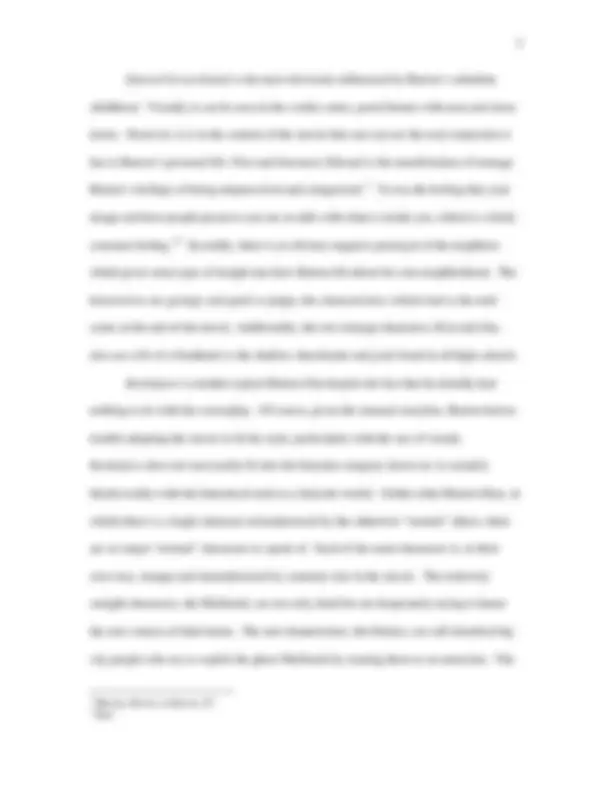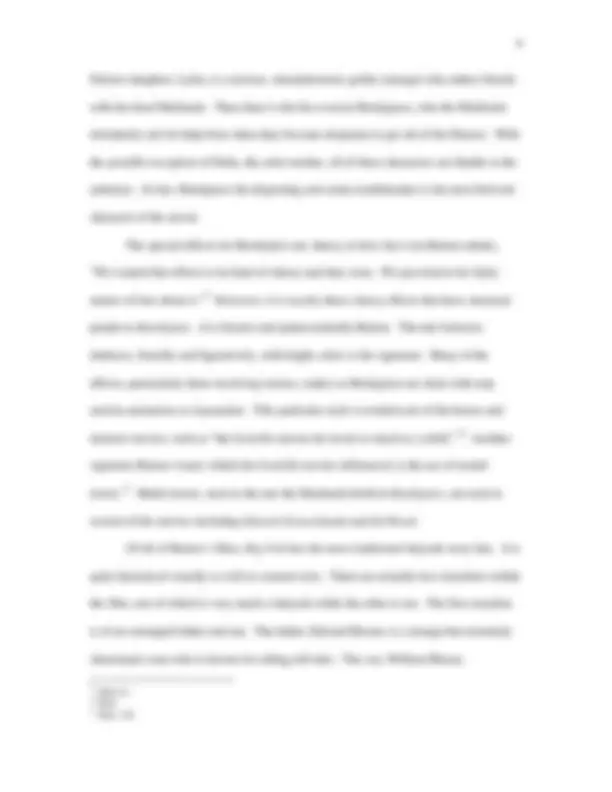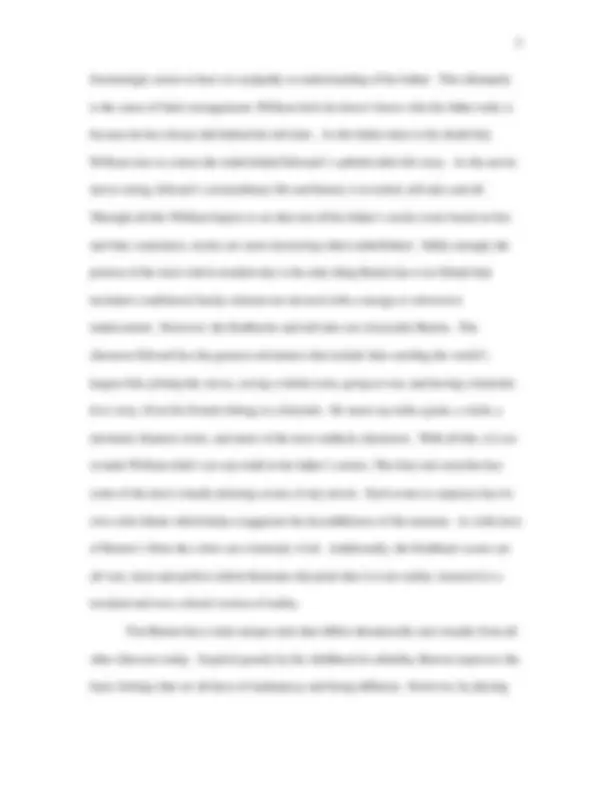





Study with the several resources on Docsity

Earn points by helping other students or get them with a premium plan


Prepare for your exams
Study with the several resources on Docsity

Earn points to download
Earn points by helping other students or get them with a premium plan
Community
Ask the community for help and clear up your study doubts
Discover the best universities in your country according to Docsity users
Free resources
Download our free guides on studying techniques, anxiety management strategies, and thesis advice from Docsity tutors
Material Type: Paper; Professor: Craft; Class: Hollywood+America; Subject: History; University: California State University - Sacramento; Term: Fall 2006;
Typology: Papers
1 / 7

This page cannot be seen from the preview
Don't miss anything!




Stephanie Brown Hist. 169 Prof. Craft Nov. 26th (^2008)
Tim Burton: Director of Fairytales? Tim Burton is one of the most talented and stylized directors around today. His quirky storylines and fantastical visual style has cemented him as one of the most innovative and revered directors in Hollywood. He has a unique style which has garnered him a mass of devoted fans. Burton grew up in Burbank California, a quintessential American suburb. His suburban upbringing, along with the monster and horror films he watched as a child, are certainly the greatest influences for his films. It is from these influences that Tim Burton has established a common theme in all of his movies. This common theme is to convey a fairytale like story, and within that story, feature a strange and misunderstood (but still likable) character that has to deal with conflicting inner and outer selves.^1 Films such as Edward Scissorhands , Beetlejuice and Big Fish are great examples of Burton’s typical film style containing fairytale elements and misunderstood characters. Growing up in Burbank, Burton often felt lonely and misunderstood. As an escape from the sterility of suburbia he spent a lot of his time at the movies. Burton was particularly attracted to the monster movies such as King Kong , Godzilla , and The Creature from the Black Lagoon. For Burton, he feels that “Every kid responds to some image, some fairy-tale image, and I felt most monsters were basically misperceived, they usually had more heartfelt souls than the human characters around them.”^2 Burton believes that horror and monster movies such as The Brain That Wouldn’t Die are close (^12) Alison McMahan, The Films of Tim Burton (New York: Continuum, 2005), 63. Tim Burton, Burton on Burton ed. Mark Salisbury ( London: Faber and Faber, 2006), 3.
to fairy tales in that they are disturbing and also full of symbolism.^3 He also asserts that his love of monster movies was a direct “reaction against a very puritanical, bureaucratic, fifties nuclear family environment.”^4 Similarly, this sort of rebellion against the blandness of suburban America may also be the reason behind his desire to fill America’s gap in cultural fairy tales.^5 Possibly the film Burton is best known for is Edward Scissorhands. Edward Scissorhands is a classic Tim Burton film; It has fairytale elements, a main character that is strange but sympathetic and, of course, terribly misunderstood. Ultimately, Edward Scissorhands is a fairytale or fable. Caroline Thompson, the screenwriter for Edward Scissorhands , calls the movie, “a fable…a story that people don’t necessarily believe, but they understand…. [ Edward Scissorhands ] is about feeling like you don’t belong…and you can’t belong.”^6 The character Edward is a creation of a genius scientist (played by Vincent Price) who unfortunately dies before he can finish Edward; therefore, he is left with just scissors in place of his hands. Edward, perhaps, is the ultimate in the strange but sympathetic characters. Having lived alone his whole life, Edward has almost no social skills and has an almost frightening appearance, but underneath, he is really sweet and goodhearted. After the local Avon lady discovers Edward she takes him home to live with her and her family. People in the neighborhood are slow to accept him until he shows, through his talents, that there is more to him than just his outward appearance. After a series of disastrous events and misunderstandings, the town is quick to turn on Edward, thus forcing him back to where he came from.
(^34) Ibid. 5 Ibid.Tim Burton, interviewed by Gavin Smith. (^6) Edward Scissorhands, DVD, Commentary.
Deitzes daughter, Lydia, is a morose, misunderstood, gothic teenager who makes friends with the dead Maitlands. Then there is the bio-exorcist Betelguese, who the Maitlands mistakenly ask for help from when they become desperate to get rid of the Dietzes. With the possible exception of Delia, the artist mother, all of these characters are likable to the audience. In fact, Betelguese the disgusting and crude troublemaker is the most beloved character of the movie. The special effects for Beetlejuice are cheesy at best, but even Burton admits, “We wanted the effects to be kind of cheesy and they were. We just tried to be fairly matter-of-fact about it.”^9 However, it is exactly these cheesy effects that have attracted people to Beetlejuice. It is bizarre and quintessentially Burton. The mix between darkness, literally and figuratively, with bright colors is his signature. Many of the effects, particularly those involving worms, snakes or Betelguese are done with stop motion animation or claymation. This particular style is reminiscent of the horror and monster movies, such as “the Godzilla movies he loved so much as a child”.^10 Another signature Burton visual, which the Godzilla movies influenced, is the use of model towns.^11 Model towns, such as the one the Maitlands build in Beetlejuice , are used in several of his movies including Edward Scissorhands and Ed Wood. Of all of Burton’s films, Big Fish has the most traditional fairytale story line. It is quite fantastical visually as well as content wise. There are actually two storylines within the film; one of which is very much a fairytale while the other is not. The first storyline is of an estranged father and son. The father, Edward Bloom, is a strange but extremely charismatic man who is known for telling tall tales. The son, William Bloom, (^910) Ibid, 61. 11 Ibid.Ibid., 65.
frustratingly seems to have no sympathy or understanding of his father. This ultimately is the cause of their estrangement; William feels he doesn’t know who his father truly is because he has always hid behind his tall tales. As the father takes to his death bed, William tries to extract the truth behind Edwards’s unbelievable life story. As the movie moves along, Edward’s extraordinary life and history is revealed, tall tales and all. Through all this William begins to see that not all his father’s stories were based on lies and that, sometimes, stories are more interesting when embellished. Oddly enough, the portion of the story told in modern day is the only thing Burton has ever filmed that included a traditional family element not skewed with a strange or subversive undercurrent. However, the flashbacks and tall tales are classically Burton. The character Edward has the greatest adventures that include him catching the world’s largest fish, joining the circus, saving a whole town, going to war, and having a fairytale love story. Even his friends belong in a fairytale. He meets up with a giant, a witch, a mermaid, Siamese twins, and more of the most unlikely characters. With all this, it is no wonder William didn’t see any truth in his father’s stories. The fairy tale storyline has some of the most visually pleasing scenes of any movie. Each scene or sequence has its own color theme which helps exaggerate the incredibleness of the moment. As with most of Burton’s films the colors are extremely vivid. Additionally, the flashback scenes are all very clean and perfect which illustrates the point that it is not reality; instead it is a tweaked and rose colored version of reality. Tim Burton has a truly unique style that differs thematically and visually from all other directors today. Inspired greatly by his childhood in suburbia, Burton expresses the basic feelings that we all have of inadequacy and being different. However, by placing
Works Cited Beetlejuice , VHS. Directed by Tim Burton. 1988, Burbank, CA: Warner Bros., 1999. Big Fish , DVD. Directed by Tim Burton. 2003, Culver City, CA: Columbia Pictures,
Edward Scissorhands Anniversary Edition, Angeles, CA: Twentieth Century Fox, 2005. DVD. Directed by Tim Burton. 1990, Los
Burton, Tim. Burton on Burton. ed. Mark Salisbury. London: Faber and Faber, 2006. Burton, Tim. “Interview.” by Gavin Smith. http://minadreams.com/timburton/EdWoodInterview.htm (20 November 2008). Mina Dreams.
McMahan, Alison. The Films of Tim Burton. New York: Continuum, 2005. Thompson, Caroline. “Commentaries.”Directed by Tim Burton,1990. Los Angeles, CA: Twentieth Century Fox, 2005. Edward Scissorhands Anniversary Edition , DVD.